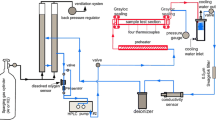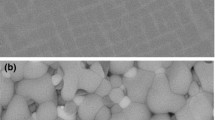Abstract
The corrosion behavior in impure helium of Haynes 230, a nickel base alloy candidate for heat exchangers in Very High Temperature Reactors (VHTR), has been investigated. The study focused on the formation and the subsequent destruction of the surface oxide layer at 900 °C and 980 °C. In-situ gas-phase analysis coupled to post-exposure surface analyses showed that a chromium-rich surface oxide formed on Haynes 230 at 900 °C but was unstable above a critical temperature T A : the chromium-rich oxide reacted with carbon in solution in the alloy to produce chromium and CO(g). The effect of carbon monoxide partial pressure in the gas phase as well as the influence of chromium and carbon activities in the alloy on T A are discussed taking thermodynamics and kinetics aspects into account.










Similar content being viewed by others
References
K. G. E. Brenner, and L. W. Graham, Nuclear Technology 66, 404 (1983).
M. Shindo, and T. Kondo, Proceedings of the Conference on Gas Cooled Reactors Today, Vol. 2 (British Nuclear Energy Society, London) 179 (1982).
W. J. Quadakkers, and H. Schuster, Werstoffe und Korrosion 36, 141 (1985).
Y. Hosoi, and S. Abe, Metallurgical Transactions A–Physical Metallurgy and Material Science 6, 1171 (1975).
M. R. Warren, High Temperature Technology 4, 119 (1986).
H. J. Christ, U. Künecke, K. Meyer, and H. G. Sockel, Materials Science and Engineering A-Structural Materials Properties Microstructure and Processing 87, 161 (1987).
W. J. Quadakkers, Werkstoffe und Korrosion 36, 335 (1985).
L. Guétaz, C. Genevois, D. Vincent, D. Venet, R. Couturier, and J.-M. Gentzbittel, Intern report (2005).
R. E. Lobnig, H. P. Schmidt, K. Hennesen, and H. J. Grabke, Oxid. Met. 37, 81 (1991).
M. Shindo, and T. Kondo, Intern report from JAERI-M 8770 (1980).
H. M. Tawancy, Oxidation of Metals 45, 323 (1996).
K. Bongartz, D. F. Lupton, and H. Schuster, Metallurgical Transactions A–Physical Metallurgy and Material Science 20A, 1021 (1989).
K. Hilpert, and I. Ali-khan, Journal of Nuclear Materials 78, 265 (1978).
K. Hilpert, and H. Gerads, Journal of Nuclear Materials 80, 126 (1979).
Y. Maru, Y. Kuramasu, Y. Awakure, and Y. Kondo, Metallurgical Transactions 2591 (1973).
Acknowledgements
The authors are thankful to Mme M. C. Lafont at the Université Paul Sabatier of Toulouse for performing TEM analyses, to Mr P. Bonnaillie for the FESEM pictures performed at the CEA/DEN/DANS/DMN/SRMP and to Mr M. Tabarant for the GDOES analyses performed at the CEA/DEN/DANS/DPC/SCP/LRSI.
Author information
Authors and Affiliations
Corresponding author
Rights and permissions
About this article
Cite this article
Rouillard, F., Cabet, C., Wolski, K. et al. Oxide-Layer Formation and Stability on a Nickel-Base Alloy in Impure Helium at High Temperature. Oxid Met 68, 133–148 (2007). https://doi.org/10.1007/s11085-007-9065-y
Received:
Revised:
Published:
Issue Date:
DOI: https://doi.org/10.1007/s11085-007-9065-y




